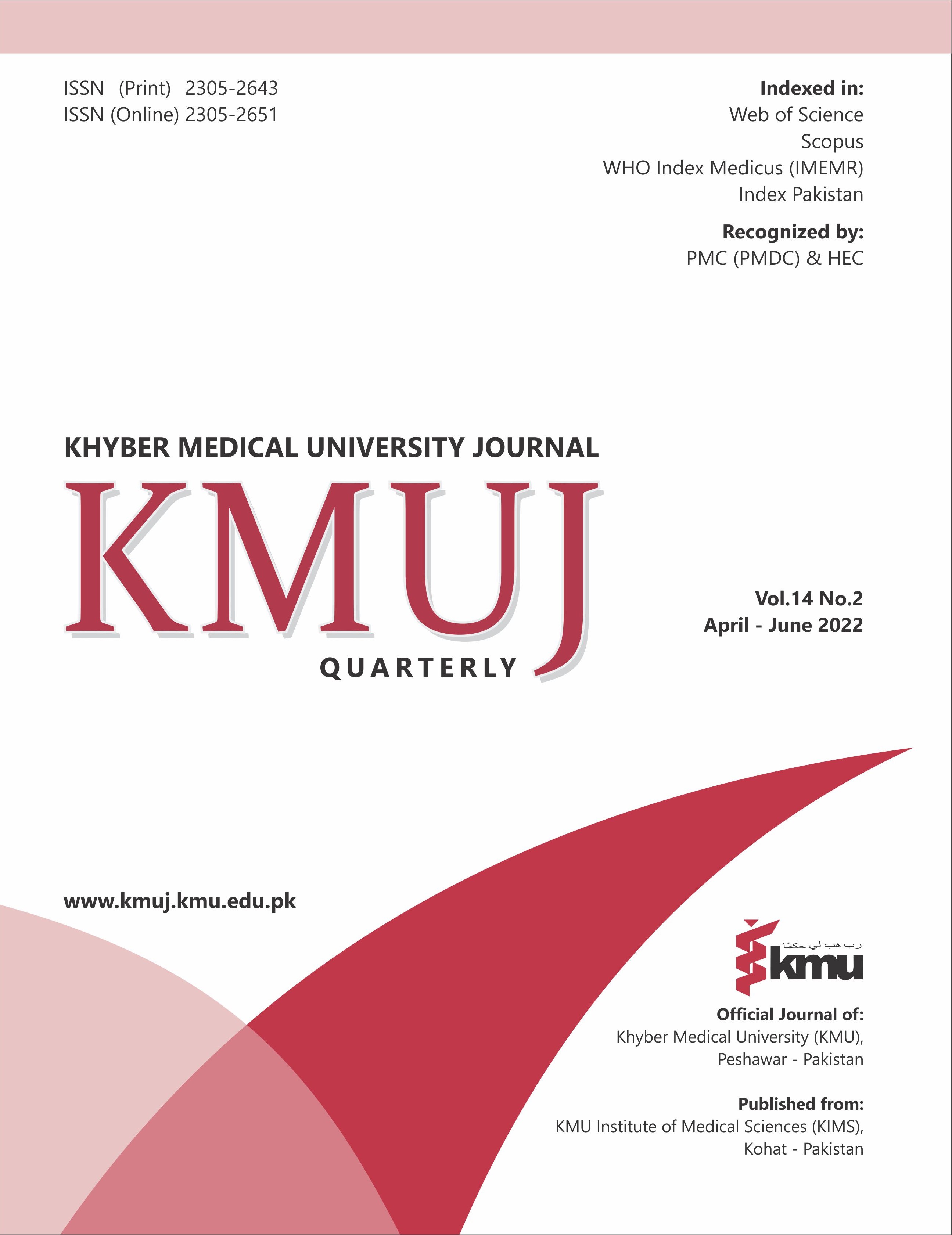ESTABLISHING CORRELATION OF pH WITH VARIOUS PHYSIOCHEMICAL AND TRADITIONAL PARAMETERS OF ACID BASE BALANCE: A CROSS-SECTIONAL STUDY
Main Article Content
Abstract
OBJECTIVE: To evaluate the effectiveness of Physiochemical versus traditional approach in diagnosing acid-base disorders (ABD).
METHODS: This cross-sectional observational study was conducted on 212 patients, admitted during January to June 2020, in intensive care unit of Rehman Medical Institute, Peshawar, Pakistan. Samples were obtained from these patients for pH, PCO2, HCO3, lactate, Na, K and Cl processed on Cobas ABG analyzer b 221. Ca, Mg, albumin and phosphate were analyzed on Cobas-601. Data was analyzed to assess the association among different parameters in traditional and Physiochemical approach.
RESULTS: Males were predominant in total cohort group (n=125/212; 59%) as well as in metabolic subgroup (n=109/184; 59%). Mean age of males and females was 55.01±11.80 years and 54.99±14.76 years respectively. pH showed a strong negative correlation with PO4 (p-value=0.001) (rs 0.238) in the total cohort of subjects and no significant correlation (p=0.005) (rs -.206) in the metabolic subgroup in physiochemical approach. In traditional approach acid base parameters, Standard Base Excess (SBE) showed strong positive correlation (p=0.001) (rs 0.413 and rs 0.567) and pCO2 showed the strongest negative correlation (p value 0.001) (rs value -0.721 and rs -0.673) with pH in both total cohort and metabolic subgroup. HCO3 (p=0.003) (rs value 0.221) and AG (p=0.024) (rs value -0.167) both showed a significant strong positive and strong negative correlation with pH respectively.
CONCLUSION: No significant association between physiochemical parameters and blood pH was found in adults. Traditional approach is the simplest, most rigorous, and useful for diagnosing ABD.
Article Details
Work published in KMUJ is licensed under a
Creative Commons Attribution 4.0 License
Authors are permitted and encouraged to post their work online (e.g., in institutional repositories or on their website) prior to and during the submission process, as it can lead to productive exchanges, as well as earlier and greater citation of published work.
(e.g., in institutional repositories or on their website) prior to and during the submission process, as it can lead to productive exchanges, as well as earlier and greater citation of published work.
References
Constable PD. Acid-base assessment: when and how to apply the Henderson-Hasselbalch equation and strong ion difference theory. Vet Clin North Am Food Anim Pract 2014;30(2):295-316. https://doi.org/10.1016/j.cvfa.2014.03.001
Siggaard‐Andersen O, Fogh‐Andersen N. Base excess or buffer base (strong ion difference) as measure of a non‐respiratory acid‐base disturbance. Acta Anaesthesiol Scand Suppl 1995; 107:123-8. https://doi.org/10.1111/j.1399-6576.1995.tb04346.x
Masevicius FD, Dubin A. Has Stewart approach improved our ability to diagnose acid-base disorders in critically ill patients. World J Crit Care Med 2015;4(1):62-70. https://doi.org/10.5492/wjccm.v4.i1.62
Shen X, Ke L, Yang D, Sun J, Tong Z, Li B, et al. The prognostic value of the strong ion gap in acute pancreatitis. J Crit Care 2016;36:140-5 https://doi.org/10.1016/j.jcrc.2016.06.035
Morgan TJ, Anstey CM, Wolf MB. A head to head evaluation of 8 biochemical scanning tools for unmeasured ions. J Clin Monit Comput 2017;31(2):449-57. https://doi.org/10.1007/s10877-016-9861-5
Morgan TJ. The Stewart approach–one clinician’s perspective. Clin Biochem Rev 2009;30(2):41-54.https://pubmed.ncbi.nlm.nih.gov/19565024
Morgan TJ. What exactly is the strong ion gap, and does anybody care. Crit Care Resusc
;6(3):155-9
Siggaard-Andersen O. The acid-base status of the blood. Scandanavian University Books, 4th Ed, Denmark: Munksgaard Publishers,;2017 https://www.cabdirect.org/globalhealth/abstract/19751427824
Chaiyakulsil C, Mueanpaopong P, Lertbunrian R, Chutipongtanate S. Connecting two worlds: Positive correlation between physicochemical approach with blood gases and pH in pediatric ICU setting. BMC Res Notes 2019;12(1):1-5. https://doi.org/10.1186/s13104-019-4770-6
Stewart P. How to understand acid base balance. A quantitative acid base primer for biology and medicine.Newyork: Elsevier;1981. https://lccn.loc.gov/80019976
Kimura S, Shabsigh M, Morimatsu H. Traditional approach versus Stewart approach for acid–base disorders: Inconsistent evidence. SAGE Open Med 2018;6:2050312118801255. https://doi.org/10.1177/2050312118801255
Ronco C, Bellomo R, Kellum J, Ricci Z. Critical Care Nephrology E-Book:3rd Ed, Elsevier Health Sciences; 2017 Dec 14. pp 1739-1791
https://www.us.elsevierhealth.com/critical-care-nephrology-9780323449427.html
Van Regenmortel N, Verbrugghe W, Van den Wyngaert T, Jorens PG. Impact of chloride and strong ion difference on ICU and hospital mortality in a mixed intensive care population. Ann Intensive Care 2016;6(1):91. https://doi.org/10.1186/s13613-016-0193-x.
Wooten EW. Calculation of physiological acid-base parameters in multicompartment systems with application to human blood. J Appl Physiol (1985) 2003;95(6):2333-44. https://doi.org/10.1152/japplphysiol.00560.2003
Story DA. Stewart acid-base: a simplified bedside approach. Anesth Analg 2016;123(2):511-15. https://doi.org/10.1213/ane.0000000000001261
Hughes R, Brain MJ. A simplified bedside approach to acid–base: fluid physiology utilizing classical and physicochemical approaches. Anaesth Intensive Care Med 2013;14(10):445-52. https://doi.org/10.1016/j.mpaic.2013.07.013
Stewart PA. Independent and dependent variables of acid-base control. Respir Physiol 1978;33(1):9-26. https://doi.org/10.1016/0034-5687(78)90079-8
Kishen R, Honoré PM, Jacobs R, Joannes-Boyau O, De Waele E, De Regt J, et al. Facing acid–base disorders in the third millennium–the Stewart approach revisited. Int J Nephrol Renovasc Dis 2014;7:209-17. https://doi.org/10.2147/ijnrd.s62126
Morgan TJ, Kellum J, Elbers P. Stewart's textbook of acid-base: Lulu.com publishers;2009. https://books.google.com.pk/books?id=4U_50yjaD2IC&Ipg
Diaztagle-Fernández JJ, Moreno-Ladino IJ, Morcillo-Muñoz JA, Morcillo-Muñoz AF, Marcelo-Pinilla LA, Cruz-Martínez LE. Comparative analysis of acid-base balance in patients with severe sepsis and septic shock: traditional approach vs. physicochemical approach. Rev Fac Med 2019;67(4):629-34. http://dx.doi.org/10.15446/revfacmed.v67n4.65448
Cusack R, Rhodes A, Lochhead P, Jordan B, Perry S, Ball J, et al. The strong ion gap does not have prognostic value in critically ill patients in a mixed medical/surgical adult ICU. Intensive Care Med 2002;28(7):864-9. https://doi.org/10.1007/s00134-002-1318-2
Doberer D, Funk G-C, Kirchner K, Schneeweiss B. A critique of Stewart’s approach: the chemical mechanism of dilutional acidosis. Intensive Care Med 2009;35(12):2173-80. https://doi.org/10.1007/s00134-009-1528-y
Sirker AA, Rhodes A, Grounds RM, Bennett ED. Acid− base physiology: the ‘traditional’and the ‘modern’approaches. Anaesthesia 2002;57(4):348-56. https://doi.org/10.1046/j.0003-2409.2001.02447.x
